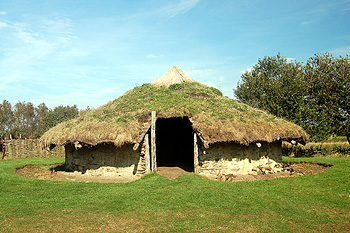Prehistory in Flitwick

A reconstruction of a Bronze Age round house at Flag Feb October 2011
The Bedfordshire Historic Environment Record [HER] contains information on the county’s historic buildings and landscapes and summaries of each entry can now be found online as part of the Heritage Gateway website. Ruxox Farm is an important Romano-British settlement site. However, prehistoric artefacts have also been found there including some demonstrating the earliest evidence for human activity in what is now Flitwick [HER 2771]. A handaxe from the Palaeolithic Era was found along with a small flint engraving tool called a burin from the Mesolithic and flint tools from Mesolithic, Neolithic and Bronze Age. Four flint tools being found by fieldwalking on the site of an old sand pit at Priestley Farm are Mesolithic in date [HER 19694]. More Mesolithic tools were discovered west of Priestley farm during construction of a pipeline [HER 15844] as well as more tools from Neolithic and Bronze Age.
Cropmarks north of Spring Valley Farm in an area known as Potters Close may be prehistoric [HER 562]. Cropmarks are differences in the rate of growing crops relating to soil disturbances from such things as buried walls and old ditches. The marks may represent a prehistoric enclosure and a boundary ditch from the Romano-British period.
Eighteen late Neolithic and early Bronze Age flint tools have been found south-west of Flitwick Plantation [HER 13485]. Bronze Age occupation in Flitwick is evidenced from a pottery beaker and animal bone found by Manshead Archaeological Society [HER 7733].